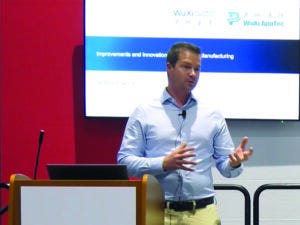- Sponsored Content
Improvements and Innovations in Lentiviral ManufactureImprovements and Innovations in Lentiviral Manufacture
August 24, 2022
Sponsored by WuXi Advanced Therapies
 Ryan Cawood, chief scientific officer, WuXi Advanced Therapies.
Ryan Cawood, chief scientific officer, WuXi Advanced Therapies.
In this presentation, Cawood focused on transient lentiviral manufacturing, plasmid creation and analysis, and stable cell-line development for continuous lentiviral production. The work is performed at WuXi Advanced
Therapies facilities in Philadelphia, PA, based on methods developed at the company’s research institute in Oxford, UK. The latter site was Oxgene, a company that Cawood founded and that was acquired by WuXi Advanced Therapies in 2021.
The WuXi Advanced Therapies transient lentiviral manufacturing platform includes all necessary components, processes, standard operating procedures (SOPs), and analytical methods to develop a customer’s lentiviral vector as an “out-of-the-box” solution up to ~200-L production scale. Process development teams can customize and generate specific assays as needed, and scale-out can expand manufacturing productivity without risks associated with larger bioreactors.
A primary means of improving transient production processes, Cawood explained, is genetic engineering of plasmid vectors. The Oxford laboratory has produced 400–500 different lentiviral packaging plasmids so far, some expressing 1–2 × 108 IU/mL. Another way to optimize such processes is by focusing on the cell line used. For example, Cawood’s laboratory adapted an adherent cell line to suspension culture and created a clonal derivative with improved growth rate and viability. “We are now using that for adenovirus and lentivirus production,” he said.
He said that a laboratory can choose to optimize the culture and transfection process. Using plasmids available as off-the-shelf products and a cell line banked under good manufacturing practice (GMP) conditions with an associated drug master file (DMF), clients of WuXi Advanced Therapies can focus on process optimization. That often entails culture media supplementation and treatments as well as downstream processing (typically clarification followed by two-step column chromatography, and concentration/filtration). Cawood described the process developed and refined over 10 years at Oxgene, noting that lentiviruses are fragile and difficult to work with in downstream processing. Final yields tend to be just 10–15% of the starting material; engineering away some processing steps can improve those to 30–35% at the cost of retaining some impurities.
Using WuXi Advanced Therapies plasmids (made at a GMP facility in China and available in quantities up to 50 g), clients can take a program from DNA to filing an investigational new drug (IND) application within about a year. Beginning with a standardized platform expedites the workflow, but as Cawood noted, “every clinical product is unique.” The company can take lentiviral genetic material and create a master cell bank, then produce plasmids in 10–18 weeks.
He reported that testing takes place at a new laboratory in Oxford. During lentiviral manufacturing, WuXi Advanced Therapies can test the materials in progress. The team uses a combination of standard tests for sterility, mycoplasma, and adventitious agents associated with mammalian cell culture — along with vector-specific assays that are unique to each product. “We have an analytical development team that can set up custom assays as soon as we start working on a product.” Cawood said that the numbers and types of tests have increased over time, requiring specific and substantial investment on the laboratory side of WuXi Advanced Therapies operations.
Finally, he highlighted the progress of his laboratory’s work toward stable cell lines for lentivirus production. “It’s been the industry’s dream for some time to remove plasmids from the process, but it’s difficult because many of the genes involved in lentiviral manufacturing express as cytotoxic proteins.” That necessitates the use of an induction system. WuXi Advanced Therapies uses doxycycline to induce production of lentiviruses when a culture is ready to produce. “When you induce expression, the cells will die after three or four days.” So they must be grown to a high density before induction. Such densities aren’t compatible with plasmidbased transfection methods, of which induction systems typically run at around half the cost but with lower yields.
So the goal has been to develop a fully stable producer cell line that expresses lentiviruses at the same 108 IU/mL levels the plasmid-based process provides. Cawood reported that this goal has been achieved in 2022. “This also opens up a number of things that you can do with a bioreactor that you can’t do if you have to transfect the cells. It removes the dependency on plasmid transfection.”
To realize that goal required modifying some genes and expression cassettes, but the stable-cell system uses the same vector constructs as the transient system. That way, clients using transient transfection early on can switch to the stable production option later in development with limited comparability testing. Cawood noted that doing so ultimately improves process robustness by eliminating the variability inherent in transfection processes.
Fill out the form below to view the full BPI Theater presentation.
You May Also Like






